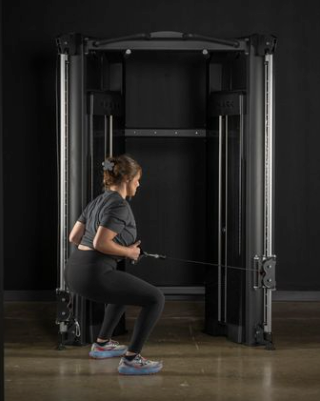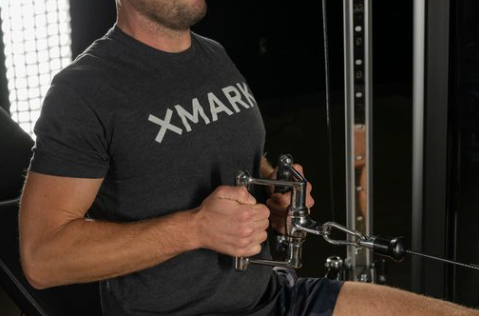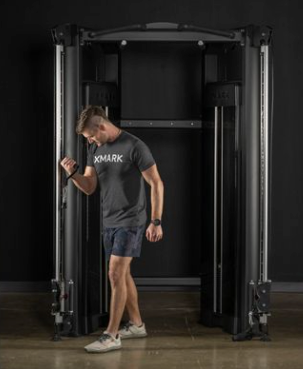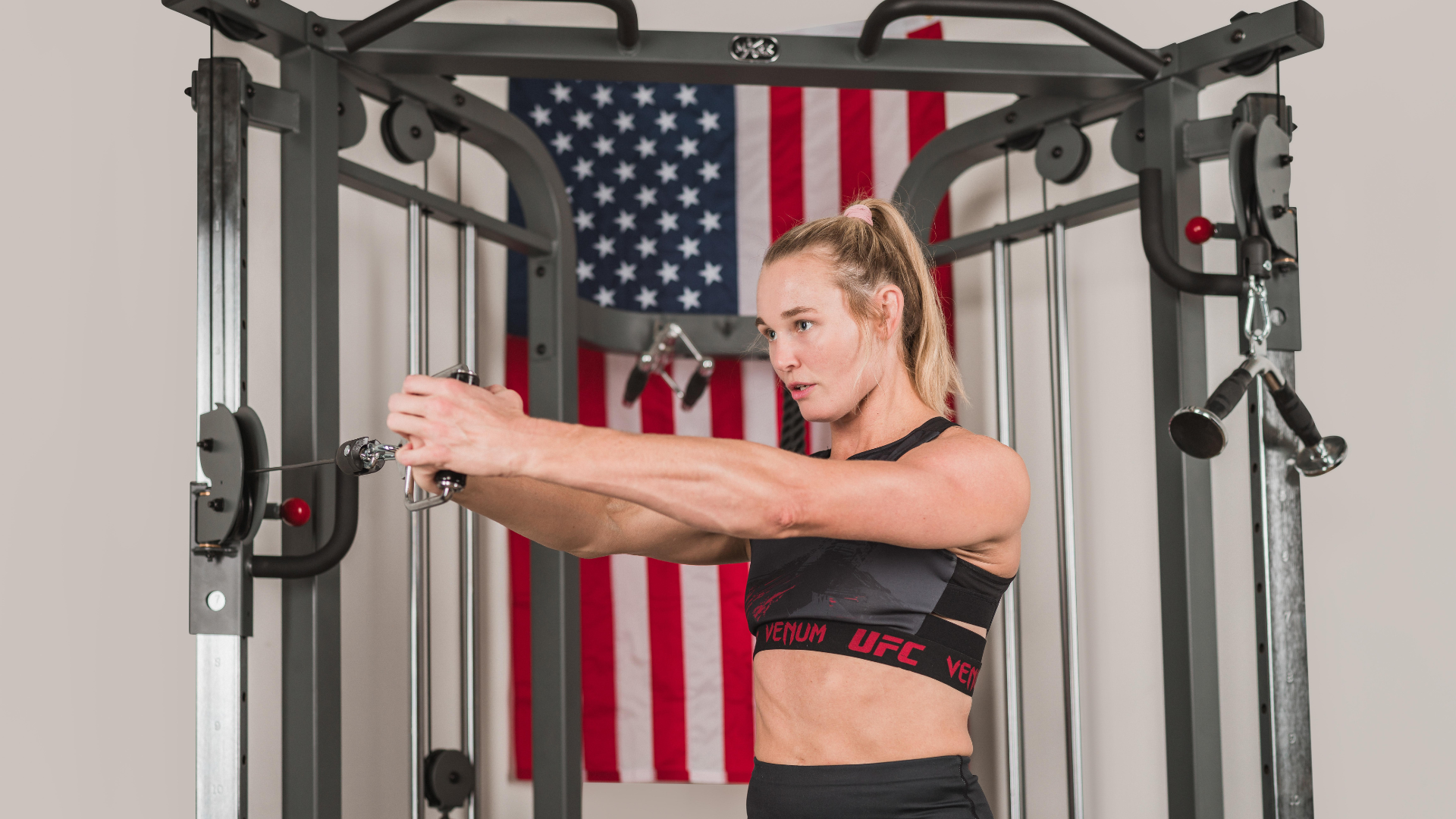Introduction to Functional Trainer Exercises
Functional training has gained significant popularity in recent years, and for good reason. It offers a holistic approach to fitness that focuses on improving your overall strength, flexibility, and mobility while emphasizing movements that mimic real-life activities. This article will explore the benefits of functional trainer workouts and provide a comprehensive list of essential exercises for beginners to try in their home gym. (We also put together a comprehensive article on What Is a Functional Trainer that breaks down features, benefits, and examples.)

Benefits of Functional Trainer Workouts
1. Full-Body Engagement
One of the primary advantages of functional trainer workouts is their ability to engage multiple muscle groups simultaneously. Traditional weightlifting often isolates specific muscles, but functional training emphasizes full-body workout movements. Whether you're pushing, pulling, or twisting, these exercises challenge your body to work as a cohesive unit, mirroring the demands of daily life.
2. Joint Stability and Mobility
Functional training enhances joint stability and range of motion. By engaging in exercises that require balance and coordination, you improve the health and function of your joints. This not only reduces the risk of injury but also helps correct muscle imbalances that can lead to chronic pain and discomfort.
3. Core Strength and Balance
The core plays a central role in functional training, as it provides the foundation for many movements. Exercises that engage the core muscles promote stability and improve overall balance and posture. A strong core is essential for preventing injuries and maintaining optimal body alignment.
4. Variety and Adaptability
One of the key features of a functional trainer machine is their versatility. With a functional trainer, you can perform a wide array of exercises, making it suitable for individuals of all fitness levels and goals. Whether you're looking to build strength, increase flexibility, or enhance endurance, most functional trainers can be tailored to meet your specific needs.
Essential Functional Trainer Exercises for Beginners
1. Squat to Row

Muscle Groups Worked: Legs, back, and core
Functional Aspect: This exercise mimics the motion of picking up an object from the ground and then lifting it overhead, making it practical for daily activities.
Instructions:
1. Stand facing the functional trainer with the handles in hand.
2. Lower into a squat while simultaneously pulling the handles towards your chest.
3. Push through your heels to stand up while extending your arms overhead.
4. Repeat for 10 repetitions in 3 sets.
2. Chest Press with Rotation

Muscle Groups Worked: Chest, shoulders, and core
Functional Aspect: This exercise replicates the motion of pushing a heavy object away from your body while twisting your torso, which is useful in various situations.
Instructions:
1. Adjust the functional trainer to chest height.
2. Stand facing away from the machine, holding the handles at chest level.
3. Push the handles forward while simultaneously rotating your torso to one side.
4. Return to the starting position and repeat for 12 repetitions on each side in 3 sets.
3. Lunge with Cable Pull
Muscle Groups Worked: Legs and core
Functional Aspect: This exercise enhances lower body strength and stability, mimicking the movements involved in walking and climbing stairs.
Instructions:
1. Attach the cable to your ankle.
2. Stand facing away from the machine, holding the cable in both hands.
3. Step back into a lunge while simultaneously pulling the cable toward your chest.
4. Return to the starting position and repeat for 10 repetitions on each leg in 3 sets.
4. Standing Cable Woodchop
Muscle Groups Worked: Core and obliques
Functional Aspect: This exercise involves a twisting motion that engages your core and mimics movements like chopping wood or swinging a golf club.
Instructions:
1. Adjust the functional trainer to shoulder height.
2. Stand perpendicular to the machine with both hands on the handle.
3. Pull the handle diagonally across your body in a chopping motion.
4. Return to the starting position and repeat for 15 repetitions on each side in 3 sets.
5. Seated Row

Muscle Groups Worked: Back and biceps
Functional Aspect: The seated row replicates the action of pulling an object toward you, which is a common movement in daily life.
Instructions:
1. Sit on the bench facing the functional trainer, with your legs extended.
2. Hold the handles with your arms fully extended.
3. Pull the handles toward your torso while squeezing your shoulder blades together.
4. Extend your arms again and repeat for 12 repetitions in 3 sets.
6. Tricep Pushdown

Muscle Groups Worked: Triceps
Functional Aspect: This exercise isolates the triceps, which are essential for various pushing movements.
Instructions:
1. Adjust the functional trainer to chest height.
2. Stand facing the machine, holding the bar with an overhand grip.
3. Push the bar down while extending your arms fully.
4. Return to the starting position and repeat for 12 repetitions in 3 sets.
7. Single-Leg Deadlift with Cable Pull
Muscle Groups Worked: Hamstrings, glutes, and core
Functional Aspect: This exercise enhances balance and hip stability while mimicking the act of bending over to pick something up.
Instructions:
1. Stand facing the functional trainer with one foot slightly off the ground.
2. Hold the cable in one hand.
3. Hinge at your hips and lower your torso while extending the cable hand toward the ground.
4. Return to the starting position and repeat for 10 repetitions on each leg in 3 sets.
8. Lat Pulldown
Muscle Groups Worked: Upper back and lats
Functional Aspect: The lat pulldown targets the muscles used in pulling and lifting movements, helping you build a strong upper body.
Instructions:
1. Adjust the functional trainer to chest height.
2. Sit on the bench facing the machine, with your knees secured under the pads.
3. Hold the bar with an overhand grip and pull it down to your chest.
4. Release the bar and repeat for 12 repetitions in 3 sets.
9. Plank with Knee Drive
Muscle Groups Worked: Core and hip flexors
Functional Aspect: This exercise enhances core strength and hip mobility, which are crucial for maintaining balance and stability.
Instructions:
1. Attach ankle straps to your ankles and secure them to the functional trainer.
2. Get into a plank position with your hands on the ground.
3. Drive one knee toward your chest while keeping your core engaged.
4. Alternate legs and repeat for 10 repetitions on each side in 3 sets.
10. Bicep Curl with Cable

Muscle Groups Worked: Biceps
Functional Aspect: This exercise isolates the biceps, which are essential for various pulling and lifting motions.
Instructions:
1. Adjust the functional trainer to chest height.
2. Stand facing the machine, holding the handles with an underhand grip.
3. Curl the handles toward your chest, contracting your biceps.
4. Extend your arms again and repeat for 12 repetitions in 3 sets.
Beginner Functional Trainer Workout Routine
Warm-up
Before starting your workout, it's essential to warm up to increase blood flow and mobility. Perform dynamic stretches like leg swings, arm circles, and bodyweight squats for 5-10 minutes.
Workout
1. Squat to Row - 3 sets of 10 repetitions
2. Chest Press with Rotation - 3 sets of 12 repetitions (each side)
3. Lunge with Cable Pull - 3 sets of 10 repetitions (each leg)
4. Standing Cable Woodchop - 3 sets of 15 repetitions (each side)
5. Seated Row - 3 sets of 12 repetitions
6. Tricep Pushdown - 3 sets of 12 repetitions
7. Single-Leg Deadlift with Cable Pull - 3 sets of 10 repetitions (each leg)
8. Lat Pulldown - 3 sets of 12 repetitions
9. Plank with Knee Drive - 3 sets of 10 repetitions (each side)
10. Bicep Curl with Cable - 3 sets of 12 repetitions
Cool-down
After your workout, perform static stretches for each major muscle group to improve flexibility and reduce muscle tension. Hold each stretch for 15-30 seconds.
Tips for Effective Functional Training
1. Start with Light Weights
If you're new to functional training, the concept of lifting weights and engaging in complex movements might feel daunting. However, starting with light weights is a fundamental step in building a strong foundation for your functional fitness journey. Here's why it's essential:
Focus on Form: Lightweights allow you to concentrate on mastering the correct form and technique for each exercise. Proper form is crucial not only for maximizing the benefits of the exercise but also for preventing injuries. It ensures that you're using the right muscles and engaging them in the right way.
Reduce Injury Risk: Lifting heavy weights without proper form can lead to injuries such as strains, sprains, and muscle imbalances. By beginning with manageable weights, you minimize the risk of overexertion and injury, enabling your muscles and joints to adapt gradually.
Build Confidence: Functional training involves complex movements that require coordination and balance. Starting with light weights helps build your confidence and competence in executing these movements correctly. As you become more comfortable, you can progressively increase the weight.
Steady Progression: Functional training is a journey, and it's essential to build a strong foundation before pushing your limits. Gradually increasing the weight as your strength improves ensures steady and sustainable progress without risking setbacks.
2. Focus on Form and Control
The mantra "form and control" is the cornerstone of functional training. It's not just about how much weight you can lift; it's about how well you can perform each movement. Here's why form and control are paramount:
Injury Prevention: Maintaining proper form reduces the risk of injury by ensuring that your muscles and joints are in their optimal positions during each exercise. It prevents overloading certain muscles and joints, which can lead to pain and injury.
Effective Muscle Engagement: Proper form ensures that you're targeting the intended muscle groups efficiently. It helps you avoid compensatory movements, where weaker muscles take over the workload, which can lead to imbalances and reduced gains.
Maximized Benefits: Functional trainer exercises are designed to work specific muscle groups and movement patterns. When you control your movements and focus on form, you extract the maximum benefit from each exercise, leading to faster progress and better results.
Better Mind-Muscle Connection: Concentrating on form and control encourages a stronger mind-muscle connection. You become more aware of how your body moves, making it easier to identify and correct any weaknesses or imbalances.
3. Rest and Recovery
Rest and recovery are often underestimated but are indispensable components of any successful training program. Here's why they matter:
Muscle Repair and Growth: During exercise, your muscles experience microscopic damage. Adequate rest allows your body to repair and strengthen these muscles, leading to growth and increased strength.
Preventing Overtraining: Overtraining can lead to fatigue, decreased performance, and a higher risk of injury. Proper rest between sets and workouts ensures that your body has sufficient time to recuperate and avoids overtraining syndrome.
Mental Rejuvenation: Rest isn't just for your muscles; it's for your mind too. Giving your mind a break from intense workouts allows you to maintain focus and motivation over the long term.
Optimal Performance: When you're well-rested, you perform better during workouts. You have more energy, better concentration, and a reduced risk of errors that could lead to injury.
4. Progression
Progression is the key to continued improvement in functional training. Here's why it's crucial to challenge your body and monitor your progress:
Continuous Adaptation: The body adapts to the demands placed on it. If you stick with the same weight and repetitions, your progress will plateau. Gradually increasing weights or repetitions challenges your body to keep adapting, leading to ongoing gains.
Muscle and Strength Development: Progressive overload is a fundamental principle of muscle and strength development. By gradually increasing the resistance or volume of your workouts, you stimulate muscle growth and enhanced strength.
Preventing Boredom: Adding variety to your workouts by progressing in terms of weight or repetitions keeps your routine fresh and exciting. This prevents boredom and helps maintain your motivation.
Tracking Progress: Monitoring your progress is essential for setting and achieving fitness goals. Whether you keep a workout journal, use a fitness app, or simply pay attention to how your body responds, tracking progress helps you make informed adjustments to your training program.
Incorporating these principles—starting with light weights, focusing on form and control, allowing for rest and recovery, and progressively challenging your body—will not only ensure a safe and effective functional training experience but also lead to long-term success in achieving your fitness goals.
Final Thoughts
Functional trainer workouts offer a holistic approach to fitness that engages multiple muscle groups, enhances joint stability, and improves core strength and balance. By incorporating these essential exercises into your home gym routine, you can work towards a well-rounded level of strength and mobility.
However, always remember to consult a fitness professional or doctor before starting a new exercise program, especially if you're a beginner. With the right guidance and commitment, functional training can help you achieve your fitness goals while enhancing your overall well-being.
Related Articles:

